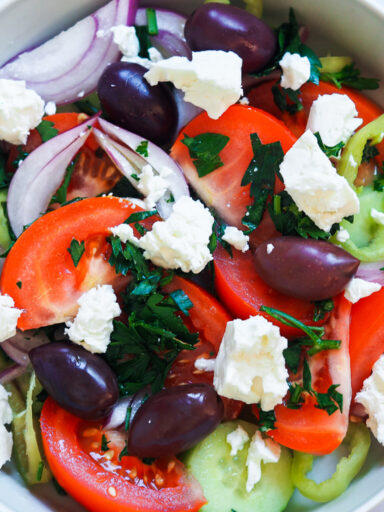Saganaki: A Greek Delight
Saganaki, a quintessential Greek dish, delights food lovers with its simplicity and rich flavours. Named after the small, two-handled frying pan in which it is traditionally cooked; saganaki has become a popular appetizer in Greek cuisine, enjoyed both in Greece and around the world.
The Origin and Tradition
The name “saganaki” derives from “sagani,” the Turkish word for a small frying pan, illustrating the dish’s cultural and historical ties to the broader Eastern Mediterranean region. Despite this shared heritage, saganaki has become a distinct and cherished part of Greek culinary tradition.
Traditionally, saganaki refers to any dish prepared in this specific pan, but it is most famously associated with fried cheese. The concept of frying cheese dates back centuries, with ancient Greeks known to have enjoyed variations of fried cheese.
Ingredients and Preparation
The classic saganaki dish centres on a few key ingredients:

Cheese: The primary ingredient, typically a firm, salty cheese that can withstand frying without melting completely. Popular choices include kasseri, kefalotyri, kefalograviera, or halloumi.
Flour: Used to lightly coat the cheese, creating a golden, crispy crust.
Olive Oil: The preferred cooking medium, providing a rich flavour and crisp texture.
Lemon: Fresh lemon wedges are served on the side, their juice squeezed over the hot cheese just before eating.
To prepare saganaki, chefs follow these simple steps:
How to Make the Saganaki
Ingredients:
1. Hard Cheese
2. Flower
3. Oil for frying
Method:
- Cut the Cheese: Slice the cheese into a piece about half an inch thick.
- Coat with Flour: Dredge the cheese slice in flour, ensuring an even, light coating. Shake off any excess flour, then deep it in water.
- Once more through the flour, the water and finally only through the flour.
- Heat the Pan: Place the sagani or a small, heavy-bottomed frying pan over medium-high heat and add enough olive oil to coat the bottom.
- Fry the Cheese: Once the oil is hot, carefully place the cheese in the pan. Fry for about 2-3 minutes on each side, or until the cheese develops a golden-brown crust.
- Serve Immediately: Transfer the fried cheese to a plate, garnish with lemon wedges, and serve hot.
Note:
Variations and Accompaniments
While the traditional cheese saganaki remains the most popular, variations of the dish showcase the versatility of this cooking method. Some alternative saganaki dishes include:
Shrimp Saganaki: Featuring shrimp cooked in a rich tomato sauce with feta cheese, garlic, and herbs.
Mushroom Saganaki: Utilizing mushrooms instead of cheese, often combined with onions, garlic, and wine for a flavourful vegetarian option.
Saganaki pairs wonderfully with other Greek appetizers, or meze, such as olives, tzatziki, and fresh bread. It also complements Greek salads and can be a delightful start to a more extensive meal.
Cultural Significance
In Greek culture, saganaki represents more than just a dish; it symbolizes the joy of sharing good food with family and friends. It often appears on the table during festive occasions and gatherings, embodying the spirit of Greek hospitality. The sight and sound of the sizzling cheese and the aromatic burst of lemon juice create an engaging sensory experience that enhances the communal dining atmosphere.
Enjoying Saganaki Around the World
Though deeply rooted in the Greek tradition, saganaki has found its way onto menus worldwide, particularly in Greek restaurants and eateries. Its universal appeal lies in its simple preparation and the irresistible combination of crispy exterior and melty, flavourful interior.
Whether enjoyed in a bustling taverna in Athens, a family gathering in a Greek village, or a Greek restaurant abroad, saganaki offers a delightful taste of Greece’s rich culinary heritage. For those who love exploring international flavours, trying or even preparing saganaki provides a delicious and accessible entry point into Greek cuisine.
In conclusion, saganaki stands out as a beloved dish that encapsulates the essence of Greek culinary tradition. Its simplicity, rich flavours, and cultural significance make it a must-try for anyone looking to experience the authentic taste of Greece.
Recommended Wine for Saganaki Greek Starter
Saganaki, a Greek starter made with fried cheese, is bold, rich, and salty, which pairs beautifully with certain wines. Here are some recommendations based on its flavours:
White Wines
A zesty Sauvignon Blanc
With high acidity and herbaceous qualities can cut through the cheese’s fat and provide a refreshing contrast.

Chardonnay Unoaked or Lightly Oaked
A lighter, unoaked Chardonnay brings hints of green apple and citrus that pair well with the saltiness of saganaki.

Rosé Wines
Dry Rosé from Provence or Greece
A dry rosé offers the acidity of white wine with a touch of berry sweetness, balancing saganaki’s savoury and salty notes.

Red Wines
Agiorgitiko from Nemea, Greece
A versatile Greek red wine, medium-bodied with soft tannins and fruity flavours, it pairs nicely with the savoury cheese.
Sweet or Fortified Wines (Optional Pairing)
Moschato (Muscat)
A slightly sweet Greek wine like Moschato can enhance saganaki’s salty and savoury qualities, especially if it’s flambéed with a liqueur-like ouzo.


Sherry Fino or Amontillado
These fortified wines have nutty and briny notes that align with the fried cheese’s flavours.

Serving Tip
Serve the wine slightly chilled (even for reds, around 12-14°C) to ensure a refreshing complement to the warm, gooey cheese of saganaki.



